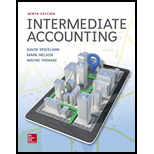
Concept explainers
Perpetual and periodic inventory systems compared
• LO8–1
The following information is available for the Johnson Corporation for 2018:
| Beginning inventory | $ 25,000 |
| Merchandise purchases (on account) | 155,000 |
| Freight charges on purchases (paid in cash) | 10,000 |
| Merchandise returned to supplier (for credit) | 12,000 |
| Ending inventory | 30,000 |
| Sales (on account) | 250,000 |
| Cost of merchandise sold | 148,000 |
Required:
Applying both a perpetual and a periodic inventory system, prepare the journal entries that summarize the transactions that created these balances. Include all end-of-period
Periodic Inventory System: Under this system, the balance of the merchandise inventory is not adjusted when the purchases and sales takes place, rather it is adjusted at the end of a particular period on a periodic basis.
Perpetual Inventory System refers to the inventory system that maintains the detailed records of every inventory transactions related to purchases and sales on a continuous basis. It shows the exact on-hand-inventory at any point of time.
To Prepare: the journal entries for the given transactions under perpetual and periodic inventory system.
Explanation of Solution
Prepare the journal entries for the given transactions under perpetual inventory system.
Purchase:
| Date | Account Title and Explanation | Post Ref. |
Debit ($) |
Credit ($) |
| Inventory | 155,000 | |||
| Accounts Payable | 155,000 | |||
| (To record the purchase of inventories on account) |
Table (1)
- Inventory is an asset and increased by $155,000. Therefore; debit the inventory account with $155,000.
- Accounts payable is a liability and increased by $155,000. Therefore, credit the accounts payable account with $155,000.
Freight:
| Date | Account Title and Explanation | Post Ref. |
Debit ($) |
Credit ($) |
| Inventory | 10,000 | |||
| Cash | 10,000 | |||
| (To record the freight cost) |
Table (2)
- Inventory is an asset and increased by $10,000. Therefore; debit the inventory account with $10,000.
- Cash is an asset and increased by $10,000. Therefore, credit the cash account with $10,000.
Purchase Returns:
| Date | Account Title and Explanation | Post Ref. |
Debit ($) |
Credit ($) |
| Accounts Payable | 12,000 | |||
| Inventory | 12,000 | |||
| (To record the return of inventories on account) |
Table (3)
- Accounts payable is a liability and decreased by $12,000. Therefore, debit the accounts payable account with $12,000.
- Inventory is an asset and increased by $12,000. Therefore, credit the inventory account with $12,000.
Sales:
| Date | Account Title and Explanation | Post Ref. |
Debit ($) |
Credit ($) |
| Accounts Receivable | 250,000 | |||
| Sales Revenue | 250,000 | |||
| (To record the sales on account) |
Table (4)
- Accounts Receivable is an asset and increased by $250,000. Therefore, debit the accounts receivable account with $250,000.
- Sales Revenue is a revenue that increases the equityby $250,000. Therefore, credit the sales revenue account with $250,000.
| Date | Account Title and Explanation | Post Ref. |
Debit ($) |
Credit ($) |
| Cost of Goods Sold | 148,000 | |||
| Inventory | 148,000 | |||
| (To record the cost of goods sold) |
Table (5)
- Cost of Goods Sold is an expense that decreases the equity by $148,000. Therefore, credit the cost of goods sold account with $148,000.
- Inventory is an asset and decreased by $148,000. Therefore, creditthe inventory account with $148,000.
Year-end Adjusting Entry:
NO ENTRY IS REQUIRED.
Prepare the journal entries for the given transactions under periodic inventory system.
Purchase:
| Date | Account Title and Explanation | Post Ref. |
Debit ($) |
Credit ($) |
| Purchases | 155,000 | |||
| Accounts Payable | 155,000 | |||
| (To record the purchase of inventories on account) |
Table (6)
- Purchase is an expense and increased by $155,000which decreased the equity. Therefore, debit the purchase account with $155,000.
- Accounts payable is a liability and increased by $155,000. Therefore, credit the accounts payable account with $155,000.
Freight:
| Date | Account Title and Explanation | Post Ref. |
Debit ($) |
Credit ($) |
| Freight-in | 10,000 | |||
| Cash | 10,000 | |||
| (To record the freight cost) |
Table (7)
- Freight-in is an expense and increased by $10,000which decreased the equity. Therefore, debit the freight-in account with $10,000.
- Cash is an asset and increased by $10,000. Therefore, credit the cash account with $10,000.
Purchase Returns:
| Date | Account Title and Explanation | Post Ref. |
Debit ($) |
Credit ($) |
| Accounts Payable | 12,000 | |||
| Purchase Returns | 12,000 | |||
| (To record the return of inventories on account) |
Table (8)
- Accounts payable is a liability and decreased by $12,000. Therefore, debit the accounts payable account with $12,000.
- Purchase returns is a contra-purchase account (with normal credit balance) and increased by $12,000. Therefore, credit the purchase returns account with $12,000.
Sales:
| Date | Account Title and Explanation | Post Ref. |
Debit ($) |
Credit ($) |
| Accounts Receivable | 250,000 | |||
| Sales Revenue | 250,000 | |||
| (To record the sales on account) |
Table (9)
- Accounts Receivable is an asset and increased by $250,000. Therefore, debit the accounts receivable account with $250,000.
- Sales Revenue is revenue that increases the equity by $250,000. Therefore, credit the sales revenue account with $250,000.
Cost of goods sold:
No entry is required for cost of goods sold under the periodic method.
Prepare the year-end Adjusting Entry.
| Date | Account Title and Explanation | Post Ref. |
Debit ($) |
Credit ($) |
| Cost of Goods Sold | 148,000 | |||
| Ending Inventory | 30,000 | |||
| Purchase Returns | 12,000 | |||
| Beginning Inventory | 25,000 | |||
| Purchases | 155,000 | |||
| Freight-in | 10,000 | |||
| (To record the cost of goods sold) |
Table (10)
- Cost of Goods Sold is an expense that decreases the equity by $148,000. Therefore, credit the cost of goods sold account with $148,000.
- Ending Inventory is an asset and increased by $30,000. Therefore, debit the inventory account with $30,000.
- Purchase returns is a contra-purchase account (with normal credit balance) and decreased by $12,000. Therefore, debit the purchase returns account with $12,000.
- Beginning Inventory is an asset and decreased by $25,000. Therefore, credit the inventory account with $25,000.
- Purchase is an expense and decreased by $155,000 which increased the equity. Therefore, credit the purchase account with $155,000.
- Freight-in is an expense and decreased by $10,000which increased the equity. Therefore, credit the freight-in account with $10,000.
Working note:
Calculate the cost of goods sold.
| Particulars | Amount ($) | Amount ($) |
| Beginning Inventory | 25,000 | |
| Add: Purchases | 155,000 | |
| Less: Purchase Returns | (12,000) | |
| Net purchases | 153,000 | |
| Goods available for sale | 178,000 | |
| Less: Ending Inventory | (30,000) | |
| Cost of goods sold | 148,000 |
Table (11)
Want to see more full solutions like this?
Chapter 8 Solutions
Loose Leaf Intermediate Accounting
- General Accountingarrow_forwardGeneral Accountingarrow_forwardKN Enterprises produces a single part for sale. The part sells for $19 per unit. Fixed costs are $1,420,000 annually. Production and sales of 640,000 units annually result in profit before taxes of $2,350,000. What is the unit variable cost?arrow_forward
- Newman Corporation sells one product, its waterproof hiking boot. It began operations in the current year and had an ending inventory of 8,500 units. The company sold 20,000 units throughout the year. Fixed manufacturing overhead is $7 per unit, and total manufacturing cost per unit is $22.60 (including fixed manufacturing overhead costs). What is the difference in net income between absorption and variable costing?arrow_forwardAt the beginning of the year, manufacturing overhead for the year was estimated to be $800,000. At the end of the year, actual labor hours for the year were 40,000 hours, the actual manufacturing overhead for the year was $775,000, and the manufacturing overhead for the year was overapplied by $25,000. If the predetermined overhead rate is based on direct labor hours, then the estimated labor hours at the beginning of the year used in the predetermined overhead rate must have been ___ Hours.arrow_forwardI need Solutionarrow_forward
- What is the operating income using variable costing on these general accounting question?arrow_forwardDaud Company has an overhead application rate of 172% and allocates overhead based on direct material cost. During the current period, direct labor cost is $59,000 and direct materials used cost is $97,000. Determine the amount of overhead Daud Company should record in the current period. Provide Answerarrow_forwardPlease provide problem with accountingarrow_forward
 Cornerstones of Financial AccountingAccountingISBN:9781337690881Author:Jay Rich, Jeff JonesPublisher:Cengage Learning
Cornerstones of Financial AccountingAccountingISBN:9781337690881Author:Jay Rich, Jeff JonesPublisher:Cengage Learning Intermediate Accounting: Reporting And AnalysisAccountingISBN:9781337788281Author:James M. Wahlen, Jefferson P. Jones, Donald PagachPublisher:Cengage LearningPrinciples of Accounting Volume 1AccountingISBN:9781947172685Author:OpenStaxPublisher:OpenStax College
Intermediate Accounting: Reporting And AnalysisAccountingISBN:9781337788281Author:James M. Wahlen, Jefferson P. Jones, Donald PagachPublisher:Cengage LearningPrinciples of Accounting Volume 1AccountingISBN:9781947172685Author:OpenStaxPublisher:OpenStax College Financial Accounting: The Impact on Decision Make...AccountingISBN:9781305654174Author:Gary A. Porter, Curtis L. NortonPublisher:Cengage Learning
Financial Accounting: The Impact on Decision Make...AccountingISBN:9781305654174Author:Gary A. Porter, Curtis L. NortonPublisher:Cengage Learning Financial And Managerial AccountingAccountingISBN:9781337902663Author:WARREN, Carl S.Publisher:Cengage Learning,
Financial And Managerial AccountingAccountingISBN:9781337902663Author:WARREN, Carl S.Publisher:Cengage Learning, Accounting (Text Only)AccountingISBN:9781285743615Author:Carl Warren, James M. Reeve, Jonathan DuchacPublisher:Cengage Learning
Accounting (Text Only)AccountingISBN:9781285743615Author:Carl Warren, James M. Reeve, Jonathan DuchacPublisher:Cengage Learning





